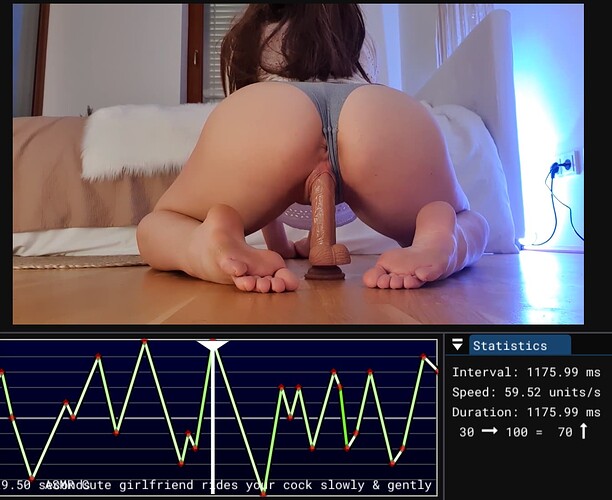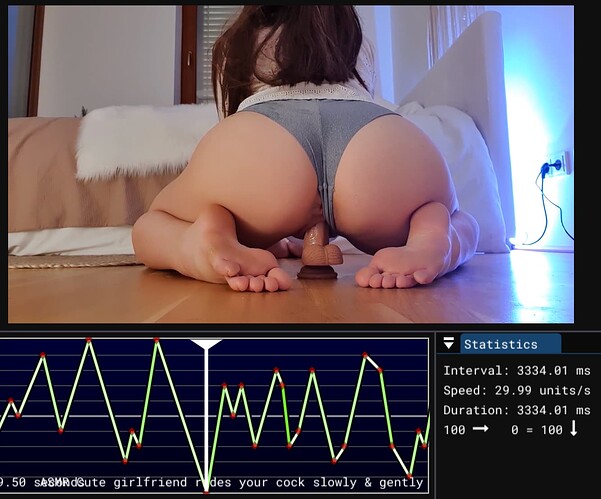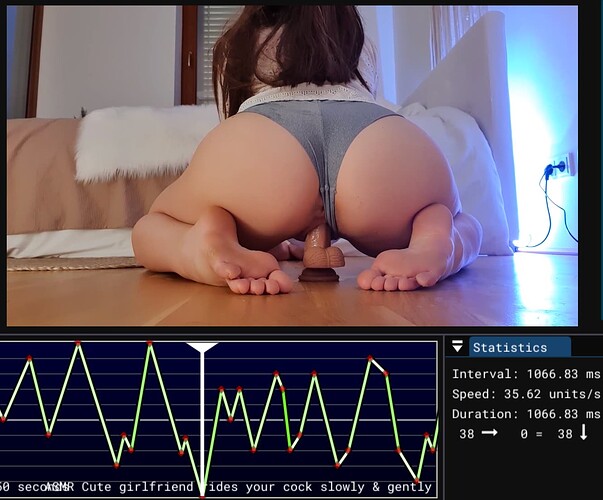I wanna hurry home to you
Put on a slow, dumb show for you and crack you up
So you can put a blue ribbon on my brain
God, I’m very, very frightened, I’ll overdo it– The National, Slow Show
Why a slow script guide?
For me, immersion is everything. I want a script to mirror what I’m seeing on the screen as well as possible. If you, like me, want to script slow scripts that are immersive and realistic - this guide is for you. I know there are different script preferences and a lot of people prefer more stimulation (vibrations, extra movement, exaggerated strokes) over realism.
I would love to see more quality slow scripts here and hope this will encourage more people to get up to speed, but also give experienced scripters some tips and inspiration to improve. There some things like device limitations making slow scripting challenging sometimes.
I will be referring to OpenFunScripter (OFS) as it is the most popular scripting tool but this guide should be pretty tool-agnostic.
If you are new to scripting, check out Sentinels How to get started and/or Huskys beginner OFS video tutorial.
Handy device limitations
Officially, the current lower limit of the Handy is 32 mm/s which translates to about 33 units/s in OFS. I did a little test and found out that it can actually go slower than this on the upstroke, at least 30 units/s can be handled.
If actions are slower than the lower limit, the Handy will try to be smart and fill in the blanks. Most commonly, it will stop for a while which is bad for immersion - it is much better if we handle this ourselves in the script. So I always try to keep the downstroke actions to at least 33 units/s and upstroke at least 30 units/s. Use the statistics component in OFS to check the speed:
Handling too slow movement
So you’ve scripted an action as accurately as possible and the speed is below 33. What to do?
If possible, extend the action by moving the point up/down. IMO, a bit too much movement is way better and more immersive than the Handy stopping or doing something unexpected. And immersion much more comes from great sync than exact stroke length. Example:
Extending the action works for most 95% of cases but sometimes the movement is just way to slow, like here:
The movement goes all the way from top to bottom so no way of extending. What I’d do here is to go against any realistic scripters intuition and put in an extra action. Ideally, somewhere she is slowing down or stuttering:
Another option I like for super slow actions is what I call “the slow wiggle”. It consists of slow (about 33 units/s) continuous up/down actions:

Vibrations (dense and short up/down actions) is also an option some scripters like. I prefer keeping actions slow instead to keep the general slow feeling in a slow script.
Either way, if you are using OFS then check out the MakeVibrations Lua script since it can be used both to create slow wiggle and vibrations.
The right amount of midpoints
Another challenge is to script the right amount of points in a slow action. Too many points and with hardly no change of movement can make the Handy stutter or the action feel choppy. Few points is often preferable - your dick won’t notice. But if the action is slowing down a lot initially or in the end of a stroke, some midpoints will definitely make the script feel more immersive. Example:


Some general rules of thumb I use:
- Watch the screen. If the movement speed is consistent, don’t add a midpoint at all. Only put midpoints if there is a distinct speed change.
- If the action is fast, there is usually not a need for a midpoint at all. Keep in mind that the Handy will naturally decelerate and accelerate at the top and bottom of a movement.
- Place the midpoint when the movement starts to slow down, typically in the first 30% and/or last 70% of the movement.
- Do not add too many midpoints. One or two is optimal in 95% of cases.
Workflow-wise, it can be effective to start off with just a simple up-down-script (maybe motion tracked) and add midpoints afterwards.
Script away!
That’s it for now. Scripting is not hard, it just takes some time and practice. So now get to it!
If you miss something here or want to discuss, feel free to add a comment. And be sure to check out my slow scripts - everything is free of course.








